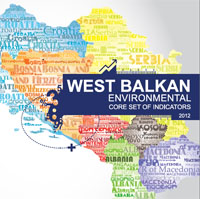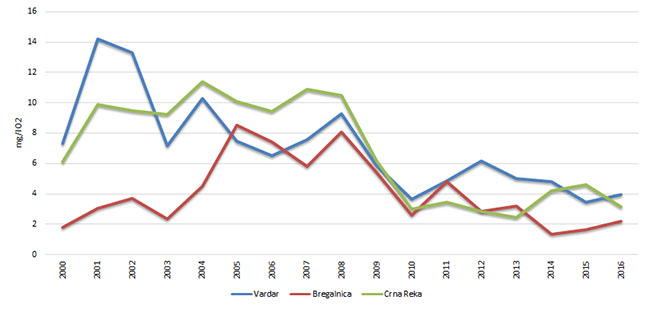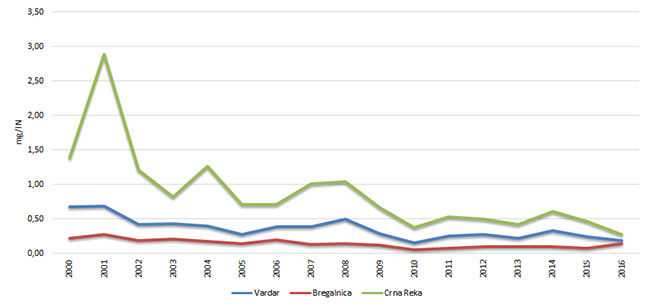| OXYGEN CONSUMING SUBSTANCES IN RIVERS |
The key indicator for the oxygenation status of water bodies is the biochemical oxygen demand (BOD) which is the demand for oxygen resulting from organisms in water that consume oxidisable organic matter. The indicator illustrates the current situation and trends regarding BOD and concentrations of ammonium (NH4) in rivers.
- Annual average BOD after 5 or 7 days incubation (BOD5/BOD7) is expressed in mg O2/l and annual average total ammonium concentrations in micrograms N/l.
Has pollution of rivers by biochemical oxygen demand (BOD5) and ammonium not noted increase?
In the Republic of Macedonia, there is a variable trend in the concentrations of BOD5 and the concentrations of ammonium in the rivers, during the period under review. The largest drop in concentrations of BOD5 is observed from 2008 to 2010. Then we observe a period of slight increase in concentrations. Ammonium concentrations in the rivers decline, starting from 2001 until 2016, when the lowest concentration was registered.
Moderate eutrophic status in relation to the level of BOD5 is registered in the river Vardar. These results can reflect the state of inefficient treatment of urban and industrial wastewater, as well as the inadequate protection of river basins.
Figure 1. Biochemical oxygen demand (BOD5) in rivers
Figure 2. Biochemical oxygen demand (BOD5) in rivers by river
Figure 3. Total ammonium in rivers
Figure 4. Total ammonium in rivers by river
Data coverage: excel
Source: MEPP, HMA
In the Republic of Macedonia, during the analyzed period, there was a changing trend in the concentrations of BOD5 and the concentrations of ammonium. In the period from 2000 to 2008, the concentration of BOD5 has a relatively stable trend, after which from 2008 to 2010 the lowest concentrations of BOD5 were registered. In the rest of the period, there is a slightly growing trend in the concentrations of BOD5.
Concerning ammonium concentrations in rivers, each year there are significant variations. The highest concentration of ammonium was recorded in 2001, followed by a decrease in concentrations. The lowest concentration was registered in 2016.
Some monitoring stations located on Crna Reka and the river Vardar, recorded moderate eutrophic status of waters, in relation to the level of BOD5. These results can reflect the state of inefficient treatment or urban and industrial wastewater in the country, as well as the inadequate protection of river basins.
Proper protection of rivers and, in particular, the introduction or regular wastewater treatment in the country is the highest political priority at the local and national level.
- Methodology for the indicator calculation
Indicators calculation is based on the methodology established by Eurowaternet, determined by the European Topic Centre for water under the European Environmental Agency.
This process defines the manner of selection of the monitoring stations, the types of parameters to be monitored, as well as thefrequency of their collection.
List of relevant policy documents:
The National Environmental Action Plan – 2,
The Environmental Monitoring Strategy and Environmental Data Management Strategy,
Strategy for Waters has been developed in order to establish long-term policy that will secure sustainable development of waters by meeting the demands of all water users, protecting waters against pollution and pollution control.
The Law on Waters transposing the following EU Directives into the national legislation:
- Framework Water Directive (FWD) 2000/60/ЕЕC, according to which, by the year of 2015, rivers in EU should achieve good ecological status or good ecological potential.
- Directive on nitrates (91/676/ЕЕC), the goal of which is to reduce nitrates and pollution by organic matter originating from agricultural lands.
- Directive on urban wastewater treatment (91/271/ЕЕC) aimed at reducing the pollution from sewerage and industrial wastewater treatment plants
The Law on Environment has transposed the Directive on Industrial Pollution Prevention and Control (IPPC) 96/61/ЕЕC is aimed at control and prevention of water resources pollution by industry.
Legal grounds
The Law on Waters prescribes the main planning documents for water protection, maintenance and permanent improvement of available water resources and sustainable use of available water quantities.
The main planning documents for water management planning and development include:
- The National Strategy for Waters
- Water Management Master Plan of the Republic of Macedonia, and
- River basin management plans.
For the purpose of maintenance and improvement of the quality of water and establishment of the adequacy of water for use for different purposes, the Law on Waters specifies classification of waters and categorization of water bodies, as well as specification of deadline for achievement of the water quality goals for each water category and specification of the minimum standards for water quality and environmental protection goals for all water bodies. According to the Law, management plan will be adopted for each river basin, in order to achieve the environmental protection objectives.
The Decree on categorization of water courses, lakes, accumulations and water resources (1999) specifies the quality of water by specific classes of water in water bodies, lakes, accumulations and groundwater resources. This Decree also establishes five categories of water courses.
Reduction and prevention of water pollution and thus achievement of good ecological status or potential of waters. Requirements of the relevant EU Directives (FWD, urban wastewater treatment, nitrates, Directive on hazardous substances, as well as Directives on drinking and bathing waters) have been transposed in the Law on Waters.
- ЕЕА
| Code | Title of the indicator | Compliance with CSI ЕЕА or other indicators | Classification by DPSIR | Type | Linkage with area | Frequency of publication | |
| MK NI 019 | Oxygen consuming substances in rivers | CSI 019 | Oxygen consuming substances in rivers | S | A | water | annual |









































































